For
more than a decade the Blackberry
Hill Site has yielded a diverse ichnofauna
and medusoid fossils that represent an ancient biota that
may
provide
the earliest
evidence of life venturing ashore during the Upper Cambrian.
While Climactichnites, Protichnites,
Diplichnites are found in multiple
horizons, this sandstone flagstone 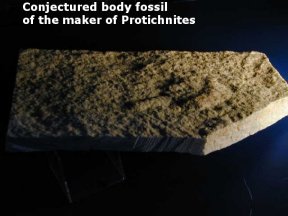 quarry
has yielded no animal fossils with hard parts except for
rumors
of some hyoliths that has as yet not been confirmed. In 2003,
however, a desiccation layer between sandstone yielded arthropod
cast body fossils of the putative maker of many of the trackways
in the quarry. We will need to wait for the publication to
have
a name, but the animal's morphology has affinity to both the
Euthycarcinoid and the Aglaspid
groups, which were both multi-legged, telson-bearing creatures.
quarry
has yielded no animal fossils with hard parts except for
rumors
of some hyoliths that has as yet not been confirmed. In 2003,
however, a desiccation layer between sandstone yielded arthropod
cast body fossils of the putative maker of many of the trackways
in the quarry. We will need to wait for the publication to
have
a name, but the animal's morphology has affinity to both the
Euthycarcinoid and the Aglaspid
groups, which were both multi-legged, telson-bearing creatures.
Euthycarcinoids
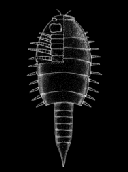 The
euthycarcinoids are poorly understood and highly enigmatic arthropods
that have at various times been assigned to nearly all major
clades of Arthropoda.
Vaccari (2004) notes that recent work has supported a placement
with crustaceans
or a myriapod-hexapod
assemblage, a basal position in the Euarthropoda, or a placement
in Hexapoda
or a hexapod stem group. The near future may better define the
elusive euthycarcinoids, as phylogenetic studies unveil the
genes involved in arthropod evolution (Schram, 2001).The euthycarcinoids
are known from 13 species from Upper Ordovician or Lower Silurian-Middle
Triassic from Western Australia, Europe (e.g., the Rhynie chert)
and the Mazon Creek in Illinois. In all cases the depositional
characteristics suggests freshwater or brackish water environments.
Recently, Vaccari (2004) described Apankura machu from a 38
mm holotype coming from late Cambrian of Argentina that occurs
along with footprints and tail-drag trackways conspicuously
similar to those of Protichnites
from the Krukowski quarry. This finding pushes back the groups
origin by some 50 million years. Since the Krukowski quarry
is probably an older Cambrian assemblage, the Krukowski ichnofauna
be the earliest arthropod fossils in the fossil record that
are associated with land-based footprints. The trackways in
the formation strengthen the theory that similar traces of subaerial
origin from Cambro-Ordovician such as the Cambrian Krukowski
quarry and the Ordovician Kingston formation in Ontario, Canada
(MacNaughton, 2002) were made by euthycarcinoids. I am also
struck that this arthropod has similarities to Fuxianhuia
protensa, a basal arthropod from the Chengjiang
Lagerstatte of China.
The
euthycarcinoids are poorly understood and highly enigmatic arthropods
that have at various times been assigned to nearly all major
clades of Arthropoda.
Vaccari (2004) notes that recent work has supported a placement
with crustaceans
or a myriapod-hexapod
assemblage, a basal position in the Euarthropoda, or a placement
in Hexapoda
or a hexapod stem group. The near future may better define the
elusive euthycarcinoids, as phylogenetic studies unveil the
genes involved in arthropod evolution (Schram, 2001).The euthycarcinoids
are known from 13 species from Upper Ordovician or Lower Silurian-Middle
Triassic from Western Australia, Europe (e.g., the Rhynie chert)
and the Mazon Creek in Illinois. In all cases the depositional
characteristics suggests freshwater or brackish water environments.
Recently, Vaccari (2004) described Apankura machu from a 38
mm holotype coming from late Cambrian of Argentina that occurs
along with footprints and tail-drag trackways conspicuously
similar to those of Protichnites
from the Krukowski quarry. This finding pushes back the groups
origin by some 50 million years. Since the Krukowski quarry
is probably an older Cambrian assemblage, the Krukowski ichnofauna
be the earliest arthropod fossils in the fossil record that
are associated with land-based footprints. The trackways in
the formation strengthen the theory that similar traces of subaerial
origin from Cambro-Ordovician such as the Cambrian Krukowski
quarry and the Ordovician Kingston formation in Ontario, Canada
(MacNaughton, 2002) were made by euthycarcinoids. I am also
struck that this arthropod has similarities to Fuxianhuia
protensa, a basal arthropod from the Chengjiang
Lagerstatte of China.
Aglaspids
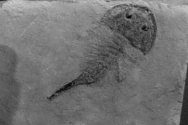 Similarly,
the Aglaspids remain enigmatic arthropods. Once placed with
chelicerates, most workers now consider them incertae sedis,
as the early arthropod phylogeny remains a highly confounded
arena. The enigmatic group of early arthropods are possibly
closely related to trilobites, and possibly link the trilobites
with the Chelicerata. Hoxie (2005) has proposed aglaspids as
among the key candidates for Protichnites
trackmakers. Aglaspid fossils are found in many Cambrian and
Ordovician fossil sites throughout the world. These arthropds
had eight to twelve pairs of appendages, and a wide range of
sizes from an inch long to nearly a foot. It
is almost certain that the aglaspids did not live on land, but
perhaps came ashore to mate and lay eggs, as horseshoe crabs
do today. Or they may have been escaping
Similarly,
the Aglaspids remain enigmatic arthropods. Once placed with
chelicerates, most workers now consider them incertae sedis,
as the early arthropod phylogeny remains a highly confounded
arena. The enigmatic group of early arthropods are possibly
closely related to trilobites, and possibly link the trilobites
with the Chelicerata. Hoxie (2005) has proposed aglaspids as
among the key candidates for Protichnites
trackmakers. Aglaspid fossils are found in many Cambrian and
Ordovician fossil sites throughout the world. These arthropds
had eight to twelve pairs of appendages, and a wide range of
sizes from an inch long to nearly a foot. It
is almost certain that the aglaspids did not live on land, but
perhaps came ashore to mate and lay eggs, as horseshoe crabs
do today. Or they may have been escaping 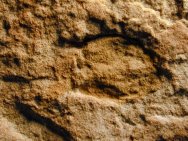 predators
that by the late Cambrian consisted of some scary creatures
such as anomolacaris. Or, perhaps microbial mats along the shoreline
provided an abundant and easy food source. Regardless, it was
a paramount event for life on earth when thethe first attempts
at land colonization were made. Morphologically, aglaspids appear
similar to the modern-day pill bug (or rolly polly), except,
like some trilobites, often had a prominent cephalon and tail
appendage or telson. Their legs, designed for strolling the
seafloor, probably would not have enabled
predators
that by the late Cambrian consisted of some scary creatures
such as anomolacaris. Or, perhaps microbial mats along the shoreline
provided an abundant and easy food source. Regardless, it was
a paramount event for life on earth when thethe first attempts
at land colonization were made. Morphologically, aglaspids appear
similar to the modern-day pill bug (or rolly polly), except,
like some trilobites, often had a prominent cephalon and tail
appendage or telson. Their legs, designed for strolling the
seafloor, probably would not have enabled 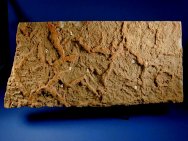 much
speed during land locomotion.
much
speed during land locomotion.
The Krukowski quarry ichnofossils are often distinguished by
ripples and fine layering in the sandstone that are characteristic
of wind-blown sand compacted over millennia, rather than underwater
sediments. Recently discovered in the Krukowski quarry are ichnofossils
coincident with raindrop impressions, further evidence of a
subaerially exposed environment where the aquatic inhabitants
of this Cambrian shoreline were venturing ashore. The Krokowski
quarry footprints in the sand may thus represent the earliest
fossil evidence in arthropod terrestrialization.
Also
see: Ichnofossil Nomenclature
References




